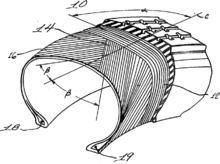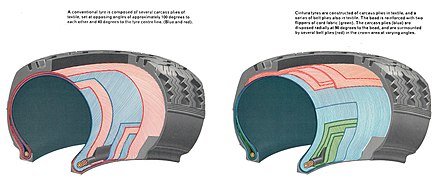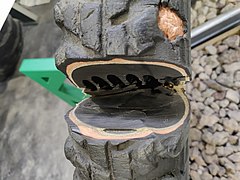Karkasse (Reifen)

Die Karkasse ist das tragende Gerüst in Luftreifen, Treibriemen und Transportbändern. Sie besteht aus Gewebe- oder Gelegeschichten (parallel angeordneten Fäden), die in Gummi eingebettet sind und dem Verbund aus Fasern und Gummi Festigkeit und Steifigkeit geben.
Das Gewebe oder die Faserlagen bestehen aus Kunstfasern wie Kunstseide, Viskosefaser, aber auch Baumwolle und andere Pflanzenfasern wurden verwendet, Nutzfahrzeugreifen haben häufig eine Stahlkarkasse. Radialreifen haben über der Karkasse unter der Lauffläche einen „Gürtel“ aus Fasern in Umfangsrichtung, üblicherweise aus Stahlcord (Stahlgürtelreifen).
- Lagenaufbau in der Karkasse eines Reifens
- Reifenschnittmodell für Ausfallsicheres Rad
- Reifenkarkasse beim Lunar Roving Vehicle
Als Maß für die Dichte des Karkassengewebes wird die Einheit tpi bzw. epi (englisch Threads / Ends per Inch – „Fäden pro Zoll“) verwendet. Diese gibt an, aus wie vielen Fasern pro Zoll die Karkasse besteht.[1]
Einzelnachweise
- ↑ Schwalbe/Ralf Bohle GmbH: Was bedeutet die EPI Zahl bei den Karkassen?, abgerufen am 18. Januar 2013
Auf dieser Seite verwendete Medien
The comparison cutaway between a standard radial tire and a Pirelli Cinturato radial tire.
Text inside:
"A conventional tyre is composed of several carcass plies of textile, set at opposing angles of approximately 100 degrees to each other and 40 degrees to the tyre central line. (Blue and red)."
"Cintura tyres are constructed of carcass plies in textile, and a series of belt plies also in textile. Te bead is reinforced whith two flippers of cord fabric (green) The carcass plies (blue) are disposed radially at 90 degrees to the bead, and are surmounted by several belt plies (red) in the crown area at varying angles."
A close-up view of the lunar roving vehicle (LRV) at the Taurus-Littrow landing site photographed during Apollo 17 lunar surface extravehicular activity. Note the makeshift repair arrangement on the right rear fender of the LRV. During EVA-1 a hammer got underneath the fender and a part of it was knocked off. Astronauts Eugene A. Cernan and Harrison H. Schmitt were reporting a problem with lunar dust because of the damage fender. Following a suggestion from astronaut John W. Young in the Mission Control Center at Houston the crewmen repaired the fender early in EVA-2 using lunar maps and clamps from the optical alignment telescope lamp. Schmitt is seated in the rover. Cernan took this picture. Technical information: Rear View from Station 2, Lunar Roving Vehicle LRV, taken during the second Extravehicular Activity EVA 2 of the Apollo 17 mission. Original film magazine was labeled C, film type was SO-368 Color Exterior, CEX, Ektachrome MS, color reversal 60mm lens with a sun elevation of 27 degrees.
Cross-section diagram of a tire (tyre) showing the plies. Numbers 14 and 16 are bias-plies and number 12 is a radial ply.
Autor/Urheber: Archiv Wehrtechnische Studiensammlung Koblenz, Lizenz: CC BY-SA 4.0
LuKa-Reifen in der WTS-02






